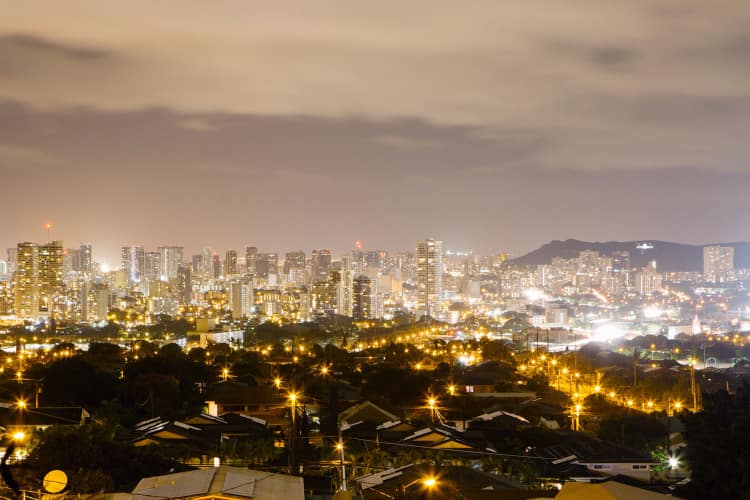These Native Hawaiian Musicians Are Bringing Their Island’s History To The World
“In Hawaiian music we are sharing our stories, genealogy, the chronology of Hawaiʻi, and who we are.”

Art and activism in Hawaiʻi are fundamentally intertwined. Native Hawaiian artists use poetry, art, mele (songs), ʻoli (chant), and hula (dance) to share individual visions of Hawaiʻi, intertwining family history, their connection to the land, and the legacy of the indigenous people. These stories are inherently rooted in resistance given the continuing tumultuous political history of the Kingdom of Hawaiʻi, formally established in 1795. From colonization to the overthrow of the Hawaiian Monarchy to statehood and continuing to this day, Native Hawaiians have been fighting for the sovereign rights of their land and their people.
Grammy-winning mele singer/songwriter Kalani Peʻa, spoken word poet Jamaica Heolimeleikalani Osorio, and pop singer/songwriter Kimié Miner belong to a growing number of Native Hawaiian artists connecting with audiences around the world. Within Hawaiʻi, their generation is empowering young people to become creators and storytellers through contemporary musical styles, expanding on ideas of what Hawaiian art and activism mean today. At a time when many Americans are looking to better connect with each other by sharing their truths, Hawaiians are reaching out with art that reflects their own struggle and resistance.
Kimié, singer/songwriter
I’m native Hawaiian, but the music I create is definitely more contemporary. It’s an exciting time for artists in Hawai’i, especially with Kalani Peʻa being the first Hawaiian to win a Grammy in the regional roots category. That’s inspired me. I think ears are now turned not just to traditional Hawaiian music, like slack key and ukulele, but other styles of music coming out of here, too. Young musicians in Hawaiʻi are no longer thinking about local radio because of Soundcloud and YouTube. They don’t really have to conform to what they think they need to be sustainable here in Hawaiʻi — they can do something different. There’s a producer, Christian Mochizuki from Hawaiʻi Kai, who’s worked with Kanye West; because of the internet he was able to get his music heard, and he’s not making Hawaiian music at all. We can be a source for today’s pop and mainstream. We have all of those resources and amazingly talented people here.
I think people view Hawaiʻi as just a little group of islands, but our ancestors were navigators and world thinkers. Our culture has a lot a lot of depth to it, much more than what is perceived by the outside world. And before the European settlers came to Hawaiʻi and “discovered” it, we had already been navigating. We weren’t afraid of inventions and new ideas, we weren’t afraid of the new frontier, but we had a set of values that we used to get us where we were going. I think people who get to hang out with friends who live here get the true meaning of what Hawaiʻi is — like an off-the-beaten-path kind of thing. It’s not Waikiki.
Bob Marley was able to explain to his people what was going on in politics in a way that they could relate to. In Hawaiian, we call that kauna [hidden meaning]. A lot of Hawaiian musicians write that way; we’ll sing about food, nature, and specific places as a reference to some other meaning. Maybe a person couldn’t sing about something, maybe they were in love with someone they weren’t supposed to be with. Instead, they would talk about missing the coolness of the mountain. That, to me, is so powerful. I love that kind of writing.
Thank god for the internet. Natives across the world have a stronger, more unified voice. Look at the Mauna Kea protests and the Dakota Access Pipeline protests. This totally translates into music. Hawaiians are bringing back ancient chants that are about joining together. It’s a call out to our brothers who are over there in North Dakota. I love hearing these old chants and songs.
We believe that the land is ours, but we are not in charge of the land. We are just stewards that take care of the land, and if we do the land will in turn take care of us. Aloha ʻāina, aloha kekahi i kekahi: treat others how you want to be treated, treat the land how you want to be treated. As a native Hawaiian, I have this responsibility to my land, to the keiki [future children]. This next album I’m really allowing myself to be open to any style, genre, or topic. Before I’d always be specific about including Hawaiian [ideas and sounds]. That’s the dilemma I think a lot of Native Hawaiians have. But when I realize that it’s in my blood, in my koko, then it’s fine. My music is Hawaiian because it comes out of me.
“Most people think of Hawaiʻi as a paradise that’s for the taking. But there are a lot of people who are working, struggling, and dying here. Hawaiʻi is the real world.” — Jamaica Heolimeleikalani Osorio
Jamaica Heolimeleikalani Osorio, spoken word artist
I was born and raised on the island of Oʻahu in the Palolo Valley. I’ve been doing spoken word since 2007. My dad’s a musician, activist, and historian at the University of Hawaiʻi at Manoa, and I currently work there in Native Hawaiian student services while pursuing my PhD in Hawaiian literature. I describe myself as a queer kanaka maoli [Native Hawaiian] poet, scholar, and activist.
It was a surprise that I got involved in poetry because I grew up in an immersion school, which meant that I didn’t learn to write formally in English until fifth grade. I had a lot of insecurities around writing and think I continue to have a lot of insecurities around writing. Spoken word has allowed me to write a poem and no one has to actually read it. They see me perform. [When I was 17] a friend took me to a poetry slam and I was absolutely hooked. It took me about a year to make it onto the state team, and then we went to this international competition called Brave New Voices. That kind of changed the trajectory of my life.
I went to college at Stanford and worked under a Chicana artist/activist/scholar who gave me the language to understand what I was already thinking about art and its transformative possibilities, that art has been and should be used for resistance and activism. Poetry matters. Not just because your voice matters, but this is something that our kūpuna [ancestors] have been doing forever. It was important for me to see where it fit within the genealogy of resistance in Hawaiʻi. When people see my work now, I hope that’s really evident to them.
The reason my father, myself, and a lot of people around me consider ourselves activists is because of the past and continued illegal occupation existing in Hawaiʻi. The United States was involved in an illegal overthrow [of the Hawaiian Kingdom] in 1893, and then later supported the illegal provisional government until 1897 when there was a proposed annexation [of Hawaiʻi to the U.S.] that failed. Annexation requires a treaty that takes a three-fourths majority vote, so instead Hawaiʻi was assumed to be ceded to the United States through a joint resolution. This is kind of important to know, to understand that under international law and even America’s own laws, the Kingdom of Hawaiʻi continues to exist. But it’s not just about the law and that political struggle; it’s also about the displacement of Native Hawaiians from their ancestral homeland, which has caused the Hawaiian diaspora to move to California, Nevada, Texas, etc. There has been a loss of Hawaiian language due to legislation in the late 19th century, and this continued settler colonial history that really prioritizes the experience of tourists and wealthy elites who have moved to Hawaiʻi since we first made contact with the Europeans in 1778.
Most people, even a lot of people who live here, think of Hawaiʻi as a paradise that’s for the taking. The first thing that needs to be deconstructed is that. It perpetuates the idea that people don’t work here, that it’s a playground. But there are a lot of people who are working, struggling, and dying here. Hawaiʻi is the real world. The more fancy multi-million dollar houses or high rises we build, the more Hawaiians and long time locals are gonna end up on the street.
What we call the Hawaiian Renaissance was really in response to the Native American and Black civil rights movements happening in America. It’s important to understand that things happening today around Mauna Kea and other issues in Hawaiʻi have actually been going on since at least the ’60s and ’70s. We are so incredibly lucky as living Native Hawaiian artists to stand on the shoulders of my parents’ generation. When they were fighting to end the bombing of Kaho’olawe in the ’70s, a lot of the kūpuna of that generation said that [the movement] wasn't Hawaiian. They had been so desensitized and removed from their traditions that they thought to be Hawaiian was to live with aloha and not be challenging. So my father and the people in his generation had to do a lot of that work almost entirely by themselves and stand up when their kūpuna were telling them, “No, you shouldn’t be doing this,” which is a big deal in the Hawaiian community to not listen.
The most important thing to me in allyship is focusing on the fact that our kūleana [responsibilities, privileges, and authority] change depending on where we are. Positionality is important. I think it’s important for anyone who gets involved in a movement, whether it’s Black Lives Matter or some indigenous rights issue, to understand the place and which people are most impacted. To take heed from people who have kūleana to that place.
“<i>Aloha ʻāina</i>, <i>aloha kekahi i kekahi</i>: treat others how you want to be treated, treat the land how you want to be treated. As a native Hawaiian, I have this responsibility.” — Kimié
Kalani Pe’a, mele singer/songwriter
I am a 33-year-old Hawaiian-Filipino man born and raised in Hilo on the Big Island, and a Hawaiian cultural practitioner and singer songwriter. I currently live on Maui. I am so proud to be the first Hawaiian singer songwriter to win a Grammy in the regional roots music category. I’m also an illustrator and have published five Hawaiian-language children stories as well. And I’ve been teaching at Kamehameha school [a school for students of Hawaiian descent] for almost 10 years. I teach Hawaiian language and a cultural curriculum that is science-based and project-based.
I’ve been speaking Hawaiian since third grade. I grew up listening to The Temptations and Stevie Wonder, but also Hawaiian artists like Robert Cazimero and Kekuhi Kanahele. I don't consider my album, E Walea, a traditional Hawaiian album. My dad introduced me to jazz and big band, which shows up in my music. I want to perpetuate Hawaiian language and arts through the songs that I compose, and leave a legacy to allow my nieces and nephews to carry on the teachings through music. Through every lyric. Through every kauna.
We should all acknowledge and mahalo [thank/honor] our kūpuna. Whether you are German or Hawaiian; my grandmother is Filipino and Hawaiian, and that’s okay. It’s okay to embrace the diversity around us. I am open as a māhū [a third gender person, similar to the idea of two-spirit]. Allan, my manager and the love of my life, stood by my side on the Grammy stage because he’s my iwi kuamoʻo, my backbone. We as proud māhū are promoting Hawaiian music, language, and education, and we do it by ourselves. I am proud to be open. I am proud that my family supports me.
And I am all about standing firm for Ka Lāhui Hawaiʻi [the Native Hawaiian sovereignty movement], and maintaining and wisely utilizing Hawaiian community resources, cultural values, wai [water] and ʻāina. I want to create music not only to define who I am, but to ensure the children I teach become aloha ʻāina warriors.
I always thought that people who aren’t from Hawaiʻi just don't understand it, that they come here to take their vacation or whatever. But that's a misconception. King Kalākaua left Hawaiʻi to meet with emperors and political figures around the world to build relationships and ensure that Hawaiʻi remained an independent country. I always thought people come here and just lather themselves in lotion and touch the honu [Hawaiian Green Sea Turtle], which is not aloha ʻāina, but I am stereotyping mainland people — of course not everybody is like that. In our own Hawaiian community there needs to be more education and insight. We need to educate each other, Hawaiian to Hawaiian, and Hawaiian to non-Hawaiian.
But Hawaiʻi is still illegally occupied. Back in our kingdom, non-Hawaiians who were born and raised here were considered part of our nation, our kūpuna. They were Japanese, Portuguese, German, Samoan, Filipino, and they came to work on the plantations. They are considered Hawaiian in the national perspective, but because we have our old aliʻi [Hawaiian royalty], we need to research the best leaders. We need to develop a sovereign nation and have our own treasury. Right now we need to have conversations about what we can do to help our education system and to mālama [care for, honor] our kūpuna. How can we put more Hawaiian music and art into the school system? We aren't just going to kick everyone out; it needs to be inclusive. America is powerful. Will they give up? I don't know.
It’s important that in Hawaiian music, we are not just leaving legacy, but we are sharing our stories, genealogy, the chronology of Hawaiʻi, and who we are. Our mele should be for the next generation, so that our stories are told. We have a way of tracking our history. We have the documentation. Hawaiʻi used to be an oral culture, but over time it has evolved. We have the technology. Let’s prepare our people to make good music: Hawaiian R&B, Hawaiian soul, whatever!




